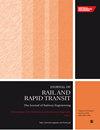Study of the lateral resistance characteristics of ballast bed considering the sleeper group effect
IF 2.1
4区 工程技术
Q3 ENGINEERING, CIVIL
Proceedings of the Institution of Mechanical Engineers Part F-Journal of Rail and Rapid Transit
Pub Date : 2023-04-01
DOI:10.1177/09544097231167730
引用次数: 0
Abstract
By establishing the ballast track full scale model, this paper tested and compared the difference between the resistance of the sleeper group and the resistance of a single sleeper, and studied the effect of sleeper group on lateral resistance. The model of the ballast bed was established based on the discrete element method. We compared the lateral resistance of ballast bed composed of different number of sleepers and analyzed the particle movement and the contact characteristic. According to case calculations, we analyzed the lateral stability of continuous welded rail (CWR) considering the effect of sleeper group. The results show that the average resistance of five sleepers decreased by about 28% compared with that of a single sleeper. With the increase of sleeper’s number, the average resistance gradually becomes stable. The reduction of lateral resistance under the effect of sleeper group mainly occurs in the ballast side and sleeper end area and there is a common area of resistance at the side and end of sleepers. When the sleeper displacement reaches 2 mm, the contribution rate of crib resistance in the independent area and the common area is about 4.3:1:1, and the contribution rate of shoulder resistance is about 3.2:1:1. To ensure the safety of the CWR operation, it is suggested that at least three sleepers should be pushed at the same time when testing the lateral resistance and use the average lateral resistance as a reference value.考虑轨枕群效应的压载床横向阻力特性研究
本文通过建立道砟轨道全尺寸模型,测试比较轨枕组阻力与单轨枕阻力的差异,研究轨枕组对横向阻力的影响。基于离散元法建立了压载床的模型。比较了不同枕木数量组成的压载床的横向阻力,分析了颗粒运动和接触特性。通过实例计算,分析了考虑轨枕群影响的连续焊轨横向稳定性。结果表明,五个睡眠者的平均阻力比一个睡眠者降低了约28%。随着睡眠人数的增加,平均阻力逐渐趋于稳定。轨枕组作用下的横向阻力减小主要发生在压载物侧和轨枕端区,轨枕侧和端区存在共同的阻力区域。当轨枕位移达到2mm时,独立区和公共区婴儿床阻力的贡献率约为4.3:1:1,肩阻力的贡献率约为3.2:1:1。为保证CWR运行安全,建议在测试侧阻力时,至少同时推3个枕木,并以平均侧阻力为参考值。
本文章由计算机程序翻译,如有差异,请以英文原文为准。
求助全文
约1分钟内获得全文
求助全文
来源期刊

CiteScore
4.80
自引率
10.00%
发文量
91
审稿时长
7 months
期刊介绍:
The Journal of Rail and Rapid Transit is devoted to engineering in its widest interpretation applicable to rail and rapid transit. The Journal aims to promote sharing of technical knowledge, ideas and experience between engineers and researchers working in the railway field.
 求助内容:
求助内容: 应助结果提醒方式:
应助结果提醒方式:


